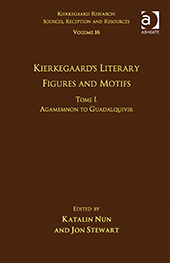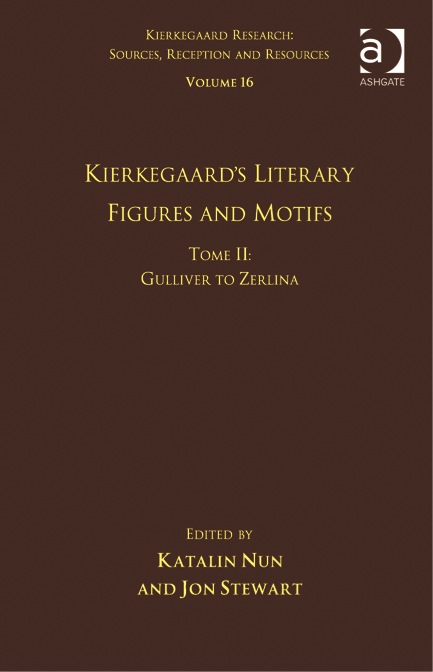Volume 16:
Kierkegaard’s Literary Figures and Motifs
Edited by Katalin Nun and Jon Stewart
Tome I:
Agamemnon to Guadalquivir
Farnham and Burlington: Ashgate 2015. xix+296pp.
Tome II:
Gulliver to Zerlina
Farnham and Burlington: Ashgate 2015. xv+267pp.
While
Kierkegaard is perhaps known best as a religious thinker and
philosopher, there is an unmistakable literary element in his writings.
He often explains complex concepts and ideas by using literary figures
and motifs that he could assume his readers would have some familiarity
with. This dimension of his thought has served to make his writings far
more popular than those of other philosophers and theologians, but at
the same time it has made their interpretation more complex.
Kierkegaard readers are generally aware of his interest in figures such
as Faust or the Wandering Jew, but they rarely have a full appreciation
of the vast extent of his use of characters from different literary
periods and traditions. The present volume is dedicated to the
treatment of the variety of literary figures and motifs used by
Kierkegaard.
Tome I: Agamemnon to Guadalquivir
Agamemnon:
From Ancient Tragic Hero to Modern Ethical Archetype
Laura Liva
Agnes and the Merman: Abraham as Monster
Nathaniel Kramer
Aladdin: The Audacity of Wildest Wishes
Jennifer Veninga
Amor: God of Love—Psyche’s Seducer
Frances Maughan-Brown
Antigone: The Tragic Art of Either/Or
Shoni Rancher
Ariadne: Kierkegaard’s View on Women, Life and Remorse
Filipa Afonso
Marie Beaumarchais: Kierkegaard’s Account of Feminine
Sorrow
Susana Janic
Bluebeard: Demonic or Tragic Hero?
Ian Panth
Captain Scipio: The Recollection of Phister’s Portrayal
as
the Comic par excellence
Timothy Stock
Cerberus: Deceiving a Watchdog and Relying on God
Filipa Afonso
Clavigo: A Little Tale about the Sense of Guilt
Antonella Fimiani
Coach Horn: Kierkegaard’s Ambivalent Valedictory to a
Disappearing Instrument
Wolter Hartog
Desdemona: The Ill-Starred Heroine of Indirect
Communication
Ana Pinto Leite
Diotima: Teacher of Socrates and Kierkegaard’s Advocate
for the Mythical
Harald Steffes
Don Juan (Don Giovanni):
Seduction and its Absolute Medium in Music
Jacobo Zabalo
Don Quixote: Kierkegaard and the Relation Between
Knight-Errant and Truth-Witness
Christopher B. Barnett
Donna Elvira: The Colossal Feminine Character,
From donna abbandonata to the Embodiment of Modern Sorrow
Sara Ellen Eckerson
Elves, Trolles, and Nisses: The Relevance of Supernatural Creatures to
Aestheticism, Philosophical Rationalism, and the Christian Faith
Will Williams
Erasmus Montanus: The Tragi-Comic Victim of the Crowd
Julie Allen
Faust: The Seduction of Doubt
Leonardo Lisi
The Fenris Wolf:
Unreal Fetters and Real Forces in Søren Kierkegaard’s Authorship
Henrike Fürstenberg
Figaro: The Character and the Opera He Represents
Sara Ellen Eckerson
Furies: The Phenomenal Representation of Guilt
Laura Liva
Gadfly: Kierkegaard’s Relation to Socrates
Hjördis Becker
Guadalquivir: Kierkegaard’s Subterranean Fluvial
Pseudonymity
Eric Ziolkowski
Tome
II: Gulliver to Zerlina
Gulliver:
Kierkegaard’s Reading of Swift and Gulliver’s Travels
Frederico Pedreira
Hamlet: The Impossibility of Tragedy/The Tragedy of
Impossibility
Leonardo Lisi
Holger the Dane: Kierkegaard’s Mention of One Heroic
Legend
Robert Puchniak
Jeppe of the Hill: The Hedonistic Christian
Julie Allen
Niels Klim: Project Makers in a World Upside Down
Elisabete Sousa
King Lear: Silence and the Leafage of Language
King Lear
Loki: Romanticism and Kierkegaard's Critique of the
Aesthetic
Matthew Brake
Lucinde: “To live poetically is to live infinitely,” or
Kierkegaard’s Concept of Irony as Portrayed in his Analysis of
Friedrich Schlegel’s Work
Fernando Manuel Ferreira da Silva
Lady Macbeth: The Viscera of Conscience
Malgorzata Grzegorzewska
Margarete:
The Feminine Face of Faust
Antonella Fimiani
Master-Thief: A One-Man Army against the Established
Order
Nassim Bravo
Mephistopheles: Demonic Seducer, Musician, Philosopher,
and Humorist
Will Williams
Minerva: Kierkegaard's Use of a Greek Motif
Anne Nielsen
Baron Münchhausen: Charlatan or Sublime Artist
Anders Rendtorff Klitgaard
Nemesis: From the Ancient Goddess to a Modern Concept
Laura Liva
Nero: Insatiable Sensualist
Sean Turchin
Papageno: An Aesthetic Awakening of the Ethics of Desire
Marcia Morgan and Karen Hiles
Per Degn: Towards Kierkegaard's Genealogy of the Morals of
the Servitors of the State Church
Gabriel Guedes Rossatti
Prometheus: Thief, Creator and Icon of Pain
Markus Pohlmeyer
Richard III: The Prototype of the Demonic
Nataliya Vorobyova Jørgensen
Robert le diable:
A Modern Tragic Figure
Telmo Rodrigues
Typhon: The
Monster in Kierkegaard’s Mirror
David Possen
Wandering Jew (Ahasverus): Kierkegaard and the Figuration
of Death in Life
Joseph Ballan
Xerxes:
Kierkegaard’s King of Jest
Ana Pinto Leite
Zelina: A Study on How to Overcome Anxiety
Sara Ellen Eckerson














